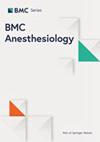内收肌管阻滞结合腘动脉与膝关节后囊之间的浸润对全膝关节置换术后慢性疼痛的影响:一项前瞻性、随机、双盲、安慰剂对照试验
IF 2.3
3区 医学
Q2 ANESTHESIOLOGY
引用次数: 0
摘要
全膝关节置换术(TKA)术后会伴有剧烈疼痛,据报道这是导致慢性疼痛的一个重要原因。事实证明,超声引导下的内收肌管道阻滞(ACB)结合腘动脉和膝关节后囊之间的浸润(IPACK)对缓解 TKA 术后急性疼痛有较好的效果。然而,该疗法对 TKA 术后慢性疼痛的发生率是否有显著影响尚未见报道。本试验旨在研究超声引导 ACB 联合 IPACK 对 TKA 术后慢性疼痛发生率和疼痛强度的影响。在这项前瞻性、随机、双盲、安慰剂对照研究中,100 名计划接受 TKA 的患者被随机(1:1)分为两组:罗哌卡因组和安慰剂组。每组患者均在超声引导下接受 ACB + IPACK 手术,使用 0.25% 罗哌卡因或等体积生理盐水。所有患者都接受了多模式镇痛。疼痛强度采用数字评分量表(NRS)进行评估。电话随访的主要结果是 TKA 术后 3 个月的慢性疼痛发生率。此外,还记录了早期休息和活动状态下的疼痛强度、慢性疼痛强度、首次抢救性镇痛时间、阿片类药物用量、术后 CRP 和 IL-6、术后住院时间、住院费用和术后并发症,以及术后早期膝关节功能。最终分析包括 91 名参与者。3个月后,罗哌卡因组的慢性疼痛发生率为30.4%,明显低于安慰剂组的51.1%。与安慰剂组相比,使用罗哌卡因的 ACB + IPACK 组在术后 4 小时、8 小时、16 小时和 24 小时的疼痛评分明显降低;术后 8 小时和 24 小时的膝关节活动范围增加;术后 3 个月的慢性疼痛发生率明显降低。在随访期间,两组患者均未出现与神经阻滞相关的并发症。在多模式镇痛方案中,与注射安慰剂相比,术前 ACB 联合 IPACK 可降低 TKA 术后 3 个月慢性疼痛的发生率和强度。此外,无论是在休息时还是在活动时,ACB 都能降低 NRS 评分,并在 TKA 术后 24 小时内改善膝关节功能。该试验于2022年11月1日在中国临床试验中心注册(注册号:ChiCTR2200065300)。本文章由计算机程序翻译,如有差异,请以英文原文为准。
Effect of adductor canal block combined with infiltration between the popliteal artery and posterior capsular of the knee on chronic pain after total knee arthroplasty: a prospective, randomized, double-blind, placebo-controlled trial
Total knee arthroplasty (TKA) is accompanied by severe postoperative pain, which is reported to be an important cause of chronic pain. Ultrasound-guided adductor canal block (ACB) combined with infiltration between the popliteal artery and posterior capsular of the knee (IPACK) has been proven to have a better effect on relieving acute pain after TKA. However, whether it has a significant effect on the incidence of chronic pain after TKA has not been reported. This trial was designed to investigate the effect of ultrasound-guided ACB combined with IPACK on the incidence and intensity of chronic pain after TKA. In this prospective, randomized, double-blind, placebo-controlled study, 100 subjects scheduled for TKA were randomly (1:1) divided into two groups: the ropivacaine group and the placebo group. Patients in each group received ultrasound-guided ACB + IPACK procedures with 0.25% ropivacaine or equal volume normal saline. All patients received multimodal analgesia. Pain intensity was assessed using the Numerical Rating Scale (NRS). The primary outcome was the incidence of chronic pain at 3 months after TKA by telephone follow-up. In addition, pain intensity in early resting and mobilized states, chronic pain intensity, the time to first rescue analgesia; opioid consumption; CRP and IL-6 after the operation; length of postoperative hospital stay; and cost of hospitalization and postoperative complications; as well as the function of the knee in the early stage after the operation, were recorded. Ninety-one participants were included in the final analysis. At 3 months, the incidence of chronic pain was 30.4% in the ropivacaine group, significantly lower than 51.1% in the placebo group. Compared with the placebo group, the ACB + IPACK with ropivacaine group had significantly lower pain scores at 4 hours, 8 hours, 16 hours, and 24 hours after the operation; increased the knee range of motion at 8 hours and 24 hours after the operation; and a significantly decreased incidence of chronic pain at 3 months after the operation. During the follow-up period, there were no nerve block-related complications in either group. In the context of multimodal analgesia protocols, ACB combined with IPACK before surgery decreases the incidence and intensity of chronic pain 3 months after TKA compared with placebo injection. In addition, it reduces the NRS scores, whether at rest or during mobilization, and improves knee function within 24 hours after TKA. This trial was registered in the China Clinical Trial Center (registration number ChiCTR2200065300) on November 1, 2022.
求助全文
通过发布文献求助,成功后即可免费获取论文全文。
去求助
来源期刊

BMC Anesthesiology
ANESTHESIOLOGY-
CiteScore
3.50
自引率
4.50%
发文量
349
审稿时长
>12 weeks
期刊介绍:
BMC Anesthesiology is an open access, peer-reviewed journal that considers articles on all aspects of anesthesiology, critical care, perioperative care and pain management, including clinical and experimental research into anesthetic mechanisms, administration and efficacy, technology and monitoring, and associated economic issues.
 求助内容:
求助内容: 应助结果提醒方式:
应助结果提醒方式:


